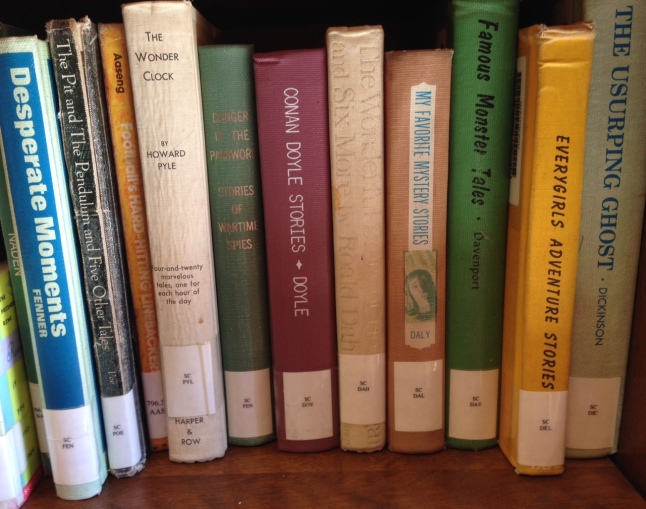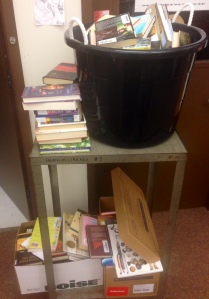
Example of the “engaging” books meant to “entice” our middle school students for the past several years.
I spent the last period of my day yesterday scavenging through the literary graveyard that was once our middle school library. The space, which has languished unattended for a few years, has officially been sentenced to obliteration in order to “re-purpose” it into a second cafeteria. As the high school librarian, I was given “first dibs” to pilfer through the musty shelves in order to snag anything worth adding to the high school collection, mainly because both schools will be sharing the HS library space and its resources next year.
For the first six years of my employment in the district, the MS library was staffed by an aide, which was not ideal by any means but at least allowed for students to visit the space and check out books; however, the aide position was cut five years ago. Since then, the space has sat primarily unattended, unused, and filled with increasingly outdated, uninteresting, decrepit and in come cases, irrelevant materials gathering dust and mildew on shelves.
Looking through the neglected materials hurt my heart – but not nearly as much as pondering the unbelievable disservice the students themselves have been subjected to by policy makers who have not valued the importance of a having a licensed media specialist in every building. Students have not only been deprived of a professional who is trained to ignite a love of reading by tailoring suggestions relevant to individual interests and reading levels, but they were deprived of SO much more.
Librarians do not simply “check out books” to students. And in this age when students are flooded with information literally at their fingertips, librarians are more important than ever in helping them navigate, evaluate, curate, and skillfully apply their new knowledge. This Infographic is a fantastic representation of what our middle school students (and staff) have been missing in the absence of a Teacher Librarian:
While inforgraphics are eye-catching and effective, I happen to be partial to lists. Following is a very condensed and edited version (my edits) of Joyce Valenza’s original Manifesto for 21st Century Librarians.These are the services and goals I that I work daily to provide to my learners and teachers. The same services and goals that have been absent in the education of our most vulnerable population for many years.
Reading: The Teacher Librarian:
● Recognizes and supplies support for new ways to promote reading. Supplies learners with audio books, Kindles, iPads,and/or Nooks
● Shares ebook apps with students for their mobile devices
● Markets, and has students share books using social networking tools like Shelfari, Good Reads, or LibraryThing.
● Provides links on websites, blogs or social media to available free ebook collections.
● Works with learners to create and share digital book talks or book trailers.
● Is the information expert in the building. Shares and teaches an ever growing and shifting array of research tools with both students and staff.
● Teaches evolving strategies for collecting information, including tags, hashtags, RSS feeds, Evernote, Google Docs, as well as traditional database searching,
● Organizes Web resources for your learning community. Curates resources on blogs, websites, Facebook page, or other portals.
● Integrates dynamic interactive features into the “Flipped” virtual 24/7 library using Google calendars, photo galleries, surveys, polls, videos, avatars, and other tools as ways to interact with and provide outreach to students, parents and community members.
Communication, Collaboration, and Publishing
● Includes and collaborates with learners. Fills both physical and virtual space with student work—their videos, original music, poetry, and art. Uses digital publishing tools to help students share and celebrate their written and artistic work.
● Understands that a library is not just a place to get stuff, it is a place to make, collaborate on, and share stuff.
Facilities, your physical space
● Knows the physical space is about books and WAY MORE than books. Welcomes and creates space for, media production—podcasting, video production, producing and presenting.
● Partners with and teaches with other teachers both in their classrooms and virtually via email, chat, Twitter, Facebook, Google+, Remind101 and websites.
Access , Equity, Advocacy
● Works to bridge the new digital divide: those who have access to new tools for creation and publishing and those who do not. Also, those who can effectively find quality information in all media formats, and those who cannot.
● Ensures that all students have access to readings appropriate for their differentiated needs.
● Partners with classroom teachers to design and implement technology, research and information literacy lessons,
Audience and Collaboration
● Helps student see that they have the potential to make social, cultural, and political impact by sharing their work and ideas globally on powerful networks.
● Views tools like Skype and Google Hangouts as ways to open the library to authors, experts, book discussion, debates, and more.
● Uses and teaches students and staff new tools for collaboration. (GoogleDocs, Edmodo, Voicethread, Animoto, Smore, Socrative, TikiToki, EasyBib, Padlet, iMovie, WeVideo, and MORE)
Copyright and Information Ethics
● Teaches students to care about and monitor their digital footprints and to develop academic–NOT invisible –-ones.
● Models respect for intellectual property.
● Lead students to web-based citation generators and note-taking tools and instruct them in their use.
● Teaches about and leads students and staff to copyright friendly portals for images, music, and information.
New Technology Tools
● Considers mobile devices to be learning tools, storage devices and reference sources. Establishes classroom or library academic guidelines and norms for use of personal mobile devices during the school day.
● Considers your role as info-technology scout. Makes “learning sense” of new tools used in business and academics. Figures out how help teachers and students use them thoughtfully.
● Knows that students will find ways to access their social media accounts despite efforts to block them. Accordingly, plans meaningful ways to incorporate social networking.
Professional Development
● Builds a personal/professional learning network using social networking tools and share these resources with staff
● Guides colleagues in setting up their own professional learning networks.
● Shares new knowledge and curriculum tools/resources with staff using tools like Diigo, Symbaloo, YouTube, Edudemic, Edmodo, Schoology,INFOhio, and Twitter
Teaching and Learning and Reference
● Helps students learn to evaluate information in all formats and guides them to make information decisions, and to evaluate all of their information choices.
● Understands that exploration and freedom are key to engaging students.
● Ensures that the library provides an independent learning environment that connects students and teachers in a social, digital, community.
● Leads and looks ahead for what is coming down the road in order to benefit for ALL learners.
Next year, I will be providing services to both the high school (9-12) and middle school (6-8) populations. Since the space will not increase, I will spend the summer restructuring the high school library environment, revising scheduling procedures, weeding resources in order to make room for 6-8 appropriate resources, cataloging new resources, and hoping to receive a budget generous enough to make the transition worthwhile to the populations I will be serving. While I am the singular library staffer, and while I also teach two Theater classes during the school day, this is, again, not an ideal situation, but it is better than districts that provide No services.
My hope is that with the increasing digital technology, global collaboration, and information literacy skills required to be college and career ready, the policy makers will recognize the necessity to fund the professional personnel infrastructure to help our students thrive.


Fantastic post! Thank you so much for advocating for librarians 🙂